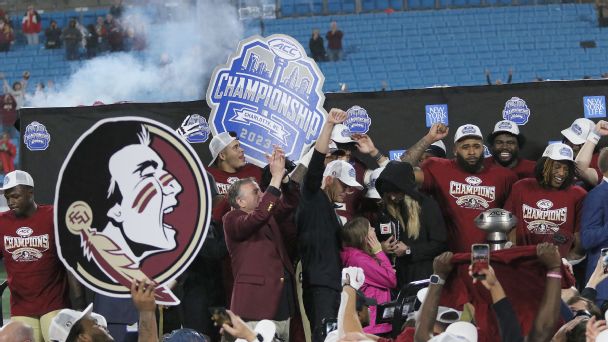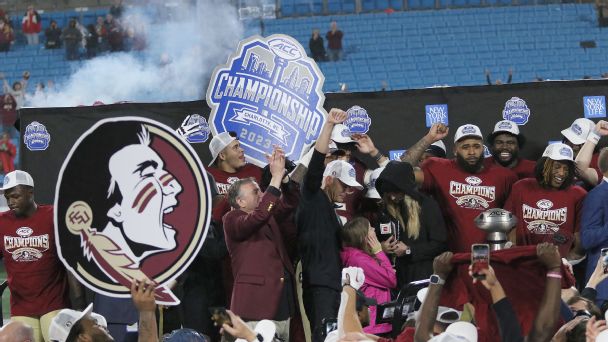
After months of politicking, Florida State took its first official step toward leaving the ACC on Friday.
Spurred into action by a College Football Playoff snub earlier this month, FSU voted to sue the ACC over the grant of rights. The school alleged restraint of trade, breach of contract and failure to perform over what it describes as years of mismanagement that has locked ACC schools in a ‘deteriorating’ media rights agreement while preventing schools from leaving with ‘draconian’ withdrawal penalties.
Translation: Florida State is ready to depart.
But can it? Here are the most pressing questions after Friday’s decision put Florida State into uncharted waters as the first school to challenge a grant of rights agreement in court.
Why is Florida State doing this now?
Florida State has made it clear that missing the College Football Playoff is not the only reason this is happening. The school has not been shy about stating its displeasure with the conference, and it vowed in August that something had to be done about its future sooner rather than later.
Missing the CFP was the last straw. At that point, the board felt the university simply could not wait any longer to take action. Florida State has been working on its legal argument since the summer. Had Florida State made the playoff, the school would have still challenged the grant of rights at some point in 2024. At its board meeting in August, trustee Justin Roth asked for an exit plan to leave the ACC by August 2024.
How much would leaving the ACC cost?
In the lawsuit, Florida State estimates it would cost $572 million to leave the ACC without a legal victory or settlement. It would forfeit $429 million in media rights through 2036, when the ACC contract with ESPN expires; $13 million in unreimbursed broadcast fees; and an exit fee of $130 million (three times the league’s total operating budget).
What is a grant of rights again? And why is it so important?
The grant of rights is a legal document signed by each current member of the ACC that transfers ownership of media rights from the school to the conference. What this means is that the ACC, not Florida State — or any other member school — owns the rights to broadcasts of games. Schools signed this in 2013 as a reaction to the departure of Maryland to the Big Ten, under the rationale that the grant of rights acts as an insurance policy that would prevent anyone from leaving the league during the duration of the agreement, which in this case is through 2036, because a school without TV revenue would have little value to any other conference or enough revenue to stand as an independent.
In other realignment scenarios, schools either waited out the grant of rights (the Pac-12’s agreement ends in summer 2024) or paid a hefty buyout to leave early (Texas and Oklahoma paid $50 million each to the Big 12 to leave that agreement just one year early).
For Florida State — or any other team looking to leave the ACC — the dollars and duration are far more imposing. With 12 seasons remaining on the existing deal after this school year, the Seminoles would need to either wait far longer than they feel is acceptable or pay a nearly impossible buyout to get their media rights back. And this is in addition to the exit fee.
Hence, option No. 3: Go to court and hope to find a legal framework for exiting sooner and at a lower cost.
What are people saying about FSU’s chances of winning?
The short answer is no one knows. One high-level administrator who has worked with legal teams to evaluate various grant of rights agreements said there are potential legal avenues that could negate the contract, but the truth is no school has ever tried to challenge a modern grant of rights in court, and no one is quite certain how a judge might interpret legal arguments.
While the grant of rights and the league’s TV contract are different documents, there is some overlap, and, as one league administrator noted, with the additions of Cal, Stanford and SMU, the ACC has enough teams to insulate itself against a dissolution of the TV deal even if FSU departs. In a technical sense, that means FSU could leave without costing any other schools TV revenue through 2036.
On the other hand, the loss of FSU would certainly devalue the overall product in the minds of TV partners, and no one would see Florida State for Cal, Stanford and SMU as an even trade.
Moreover, “winning,” in this case, is a nebulous term. Certainly Florida State hopes for a ruling that would entirely negate the grant of rights and the exit fee. Its lawyers argue in the filing that both are “unreasonable restraints of trade in the State of Florida.” They argue that the GOR and withdrawal penalty “operate in a way that prevents Florida State from competing and making the highest and best use of its media rights, and restrains the trade thereof which directly and adversely impacts not just Florida State, but all its student-athletes, coaches, staff and employees connected with its athletic programs.”
But even a favorable ruling would invariably be followed by appeals from the ACC or lawsuits from other member schools. Fighting this to the end figures to be extremely ugly for all parties concerned, so the best outcome might be a negotiated exit fee that would recoup some portion of FSU’s media valuation but not require the Seminoles to pay the whole amount.
Did any other ACC schools think about joining FSU in this suit?
The ACC has been split into various factions since Texas and Oklahoma announced their intended move from the Big 12 to the SEC in summer 2021. A seven-school contingent made waves in spring 2023, effectively pushing the league toward an agreement on imbalanced revenue sharing. Another included a narrower, four-school network of Florida State, Clemson, North Carolina and Miami, seen as the four most valuable commodities should they all hit the market, although UNC athletics director Bubba Cunningham was perhaps FSU’s loudest critic in August when the Seminoles made noise about leaving, and Virginia appears to have eclipsed Miami over the past year as a viable realignment candidate. Then there’s the dialogue between FSU and Clemson, which multiple sources have described as “working in lockstep” for the better part of the past two years as they considered their options.
Still, FSU’s decision was made alone.
Clemson — and perhaps others — could follow Florida State’s lead, but for the time being, those schools are content to let the Seminoles test the uncertain waters and take the initial heat for the decision.
Ultimately, only a handful of ACC teams are likely to have greener pastures elsewhere, but learning just how bulletproof the grant of rights is would be of interest to all 15 existing members. Florida State would welcome other league schools to join and fight the GOR together.
What would happen to the ACC if Florida State leaves?
It’s impossible to know the answer without knowing how many other schools might try to follow FSU’s lead, but the league watched the demise of the Pac-12 this past summer with enough wariness that 12 school presidents voted to add Stanford, Cal and SMU to the league to help shore up its numbers to protect its TV contract.
Aside from Clemson, North Carolina and perhaps one or two others, there’s little incentive for any other ACC schools to leave in the short term. For one thing, there’s not another landing spot that would provide TV revenue (not to mention a TV network) that would match what the league currently has — with or without FSU. Moreover, schools that stick it out would be able to get their cut of the exit fees and media rights buyout from any programs that depart — an amount that could serve as a nice golden parachute long term.
And, as one ACC athletic director told ESPN, the future of the top level of college football is so uncertain at the moment that it’s entirely possible the entire system will get upended in the next three to five years anyway, so waiting out the coming storm long enough to better project what constitutes a safe harbor might be the wisest course of action.
There is one caveat to all of this. The lawsuit claims that the ACC’s current deal with ESPN contains a unilateral option for the TV network in 2027 that must be exercised by February 2025 to extend the deal to 2036. So, if that were the case, ESPN could walk away from the deal in 14 months. Although the grant of rights is a separate document from the television contract, the two are tied together. If ESPN walks away, does that mean the grant of rights is no longer valid because there is no longer a multimedia rights deal? Or does the grant of rights carry on through 2036 no matter what? That remains unclear.
What comes next?
Under the Florida rules of civil procedure, the ACC has 20 days to file a response, which could be a motion to dismiss. Because of the holidays, the league could ask for an extension of 30 days. There are several potential outcomes to watch for: a summary judgment motion, in which a judge decides the outcome of the contract; mediation in which the ACC and Florida State work out their differences; a negotiated settlement; or a jury trial, which would happen if both sides continue to litigate with no end in sight. What remains unknown right now is what approach the ACC will take to fight this in court. The league could ask for a judge to dismiss the case with one simple argument: Florida State willingly signed the grant of rights twice: in 2013, and then again in 2016 when the league’s long-term deal with ESPN was announced.
Those briefed on the discussions are not expecting this to be resolved quickly.
What is a timeline for an ultimate resolution here?
As one ACC AD told ESPN, realignment has ruined the past two summers, and they already told their staff not to let this latest unrest unravel any holiday plans. The takeaway: This is just the start of a very, very long process.
The majority of administrators who spoke with ESPN said they expected it would be at least two to three years before any final resolution, and given the dollar figures at stake and the existential threat FSU’s departure presents to the league, neither side has much incentive to roll over without a serious fight.
Where could Florida State ultimately end up?
To be clear, Florida State does not have an invitation to join another conference right now. Before being publicly available, the grant of rights must be resolved. But let’s play this out if Florida State becomes a free agent.
The ideal conference might be the Big Ten — where it would give that league its first foothold in Florida, and allow the conference to challenge the SEC by making inroads south. Florida State president Richard McCullough arrived in 2021 from Harvard and has been working hard for admission to the Association of American Universities, which is valued by the Big Ten. A majority of the league’s schools are AAU members.
Florida State would not be choosy, though, and would certainly welcome an invite to the SEC, which would needle in-state rival Florida.
But there is one wild-card scenario out there. If a judge rules in favor of Florida State, the school would be forced to withdraw from the ACC and leave the league at the end of that athletic year. If that happens before the SEC or Big Ten is ready to expand, the Big 12 would be the only option remaining.
It is important to note here that the entire reason the ACC pushed for its schools to sign a grant of rights is because Florida State flirted with leaving the league in 2012 for … the Big 12.












